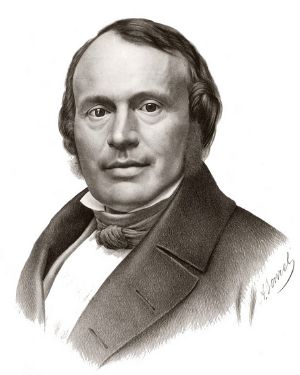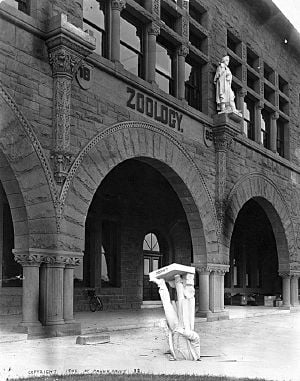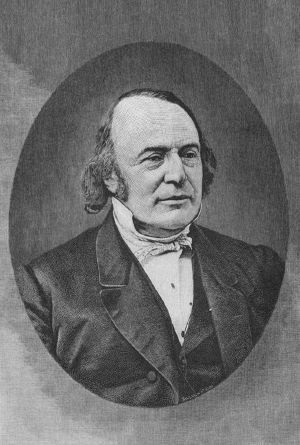Jean Louis Rodolphe Agassiz (May 28, 1807—December 14, 1873) was a Swiss-American zoologist, glaciologist, and geologist, the husband of educator Elizabeth Cabot Cary Agassiz, and one of the first world-class American scientists.
In the early stages of his career, Agassiz made a name for himself as a man who could run a scientific department well. Under his care, the University of Neuchâtel soon became a leading institution for scientific inquiry. He was appointed professor of zoology and geology at Harvard University in 1847 where he founded the Museum of Comparative Zoology in 1859 and served as the museum's first director until his death in 1873. During his tenure at Harvard, he was, among many other things, an early student of the effect of the last Ice Age on North America.
Early life and education
Louis Agassiz was born in Môtier (now part of Haut-Vully) in the canton of Fribourg, Switzerland. Educated first at home, then spending four years of secondary school in Bienne, he completed his elementary studies in Lausanne. Having adopted medicine as his profession, he studied successively at the universities of Zürich, Heidelberg, and Munich; while there he extended his knowledge of natural history, especially of botany. In 1829, he received the degree of Doctor of Philosophy at Erlangen, and in 1830 that of doctor of medicine at Munich. Moving to Paris, he fell under the tutelage of Alexander von Humboldt and Georges Cuvier, who launched him on his careers of geology and zoology respectively. Until shortly before this time, he had paid no special attention to the study of ichthyology, which soon afterwards became the great occupation of his life, if not the one for which he is most remembered in the modern day.
Early work
In 1819-1820, Johann Baptist von Spix and Carl Friedrich Philipp von Martius were engaged in an expedition to Brazil, and on their return to Europe, amongst other collections of natural objects they brought home an important set of the fresh water fish of Brazil, and especially of the Amazon River. Spix, who died in 1826, did not live long enough to work out the history of these fish, and Agassiz (though fresh out of school) was selected by Martius for this purpose. He at once threw himself into the work with an enthusiasm which characterized him to the end of his busy life. The task of describing the Brazilian fish was completed and published in 1829. This was followed by research into the history of the fish found in Lake Neuchâtel. Enlarging his plans, in 1830 he issued a prospectus of a History of the Freshwater Fish of Central Europe. It was only in 1839, however, that the first part of this publication appeared, and it was completed in 1842. In 1832, he was appointed professor of natural history in the University of Neuchâtel. The fossil fish there soon attracted his attention. The fossil-rich stones furnished by the slates of Glarus and the limestones of Monte Bolca were known at the time, but very little had been accomplished in the way of scientific study of them. Agassiz, as early as 1829, planned the publication of the work which, more than any other, laid the foundation of his world-wide fame. Five volumes of his Recherches sur les poissons fossiles ("Research on Fossil Fish") appeared at intervals from 1833 to 1843. They were magnificently illustrated, chiefly by Joseph Dinkel. In gathering materials for this work, Agassiz visited the principal museums in Europe, and meeting Cuvier in Paris, he received much encouragement and assistance from him. They had known him for seven years at the time.
Agassiz found that his palaeontological labors made necessary a new basis of ichthyological classification. The fossils rarely exhibited any traces of the soft tissues of fish. They consisted chiefly of the teeth, scales and fins, even the bones being perfectly preserved in comparatively few instances. He therefore adopted a classification which divided fish into four groups: Ganoids, Placoids, Cycloids, and Ctenoids, based on the nature of the scales and other dermal appendages. While Agassiz did much to place the subject on a scientific basis, this classification has been superseded by later work.
As Agassiz's descriptive work proceeded, it became obvious that it would over-tax his resources unless financial assistance could be found. The British Association came to his aid, and the Earl of Ellesmere—then Lord Francis Egerton—gave him yet more efficient help. The 1,290 original drawings made for the work were purchased by the Earl, and presented by him to the Geological Society of London. In 1836, the Wollaston Medal was awarded to Agassiz by the council of that society for his work on fossil ichthyology; and in 1838 he was elected a foreign member of the Royal Society. Meanwhile invertebrate animals engaged his attention. In 1837, he issued the "Prodrome" of a monograph on the recent and fossil Echinodermata, the first part of which appeared in 1838; in 1839-1840 he published two quarto volumes on the fossil Echinoderms of Switzerland; and in 1840-1845 he issued his Etudes critiques sur les mollusques fossiles ("Critical Studies on Fossil Mollusks").
Before his first visit to England in 1834, the labors of Hugh Miller and other geologists brought to light the remarkable fish of the Old Red Sandstone of the northeast of Scotland. The strange forms of the Pterichthys, the Coccosteus, and other genera were then made known to geologists for the first time. They were of intense interest to Agassiz, and formed the subject of a special monograph by him published in 1844-1845: Monographie des poissons fossiles du Vieux Gres Rouge, ou Systeme Devonien (Old Red Sandstone) des Iles Britanniques et de Russie ("Monograph on Fossil Fish of the Old Red Sandstone, or Devonian System of the British Isles and of Russia").
Proposal of an ice age
In 1837, Agassiz was the first to scientifically propose that the Earth had been subject to a past ice age. Prior to this de Saussure, Venetz, Jean de Charpentier, and others had made the glaciers of the Alps the subjects of special study, and Charpentier had even arrived at the conclusion that the erratic blocks of alpine rocks scattered over the slopes and summits of the Jura Mountains had been moved there by glaciers. The question having attracted the attention of Agassiz, he not only made successive journeys to the alpine regions in company with Charpentier, but he had a hut constructed upon one of the Aar glaciers, which for a time he made his home, in order to investigate the structure and movements of the ice. These labors resulted, in 1840, in the publication of his work in two volumes entitled Etudes sur les glaciers ("Study on Glaciers"). In it, he discussed the movements of the glaciers, their moraines, their influence in grooving and rounding the rocks over which they travelled, and in producing the striations and roches moutonnees seen in Alpine-style landscapes. He not only accepted Charpentier's idea that some of the alpine glaciers had extended across the wide plains and valleys drained by the Aar and the Rhône, but he went still farther. He concluded that, in the relatively recent past, Switzerland had been another Greenland; that instead of a few glaciers stretching across the areas referred to, one vast sheet of ice, originating in the higher Alps, had extended over the entire valley of northwestern Switzerland until it reached the southern slopes of the Jura, which, though they checked and deflected its further extension, did not prevent the ice from reaching in many places the summit of the range. The publication of this work gave a fresh impetus to the study of glacial phenomena in all parts of the world.
Thus, familiarized with the phenomena associated with the movements of recent glaciers, Agassiz was prepared for a discovery which he made in 1840, in conjunction with William Buckland. The two visited the mountains of Scotland together, and found in different locations clear evidence of ancient glacial action. The discovery was announced to the Geological Society of London in successive communications. The mountainous districts of England, Wales, and Ireland were also considered to constitute centres for the dispersion of glacial debris; and Agassiz remarked "that great sheets of ice, resembling those now existing in Greenland, once covered all the countries in which unstratified gravel (boulder drift) is found; that this gravel was in general produced by the trituration of the sheets of ice upon the subjacent surface, etc."
Relocation to the United States
In 1842-1846, he issued his Nomenclator Zoologicus, a classified list, with references, of all names employed in zoology for genera and groups — a work of great labor and research. With the aid of a grant of money from the King of Prussia, Agassiz crossed the Atlantic in the autumn of 1846 with the twin purposes of investigating the natural history and geology of North America and delivering a course of lectures on zoology, by invitation from J. A. Lowell, at the Lowell Institute in Boston, Massachusetts. The financial and scientific advantages presented to him in the United States induced him to settle there, where he remained to the end of his life.
Agassiz served as a non-resident lecturer at Cornell while also being on faculty at Harvard.[1] In 1852, he accepted a medical professorship of comparative anatomy at Charlestown, Massachusetts, but he resigned in two years. From this time his scientific studies dropped off, but he was a profound influence on the American branches of his two fields, teaching decades worth of future prominent scientists, including David Starr Jordan, Joel Asaph Allen, Joseph Le Conte, Ernest Ingersoll, Nathaniel Shaler, Alpheus Packard, and his son Alexander Agassiz, among others. He had a profound impact on the paleontologist Charles Doolittle Walcott. In return, his name appears attached to several species, as well as here and there throughout the American landscape, notably Lake Agassiz, the Pleistocene precursor to Lake Winnipeg and the Red River.
During this time he grew in fame even in the public consciousness, becoming one of the best-known scientists in the world. By 1857, he was so well-loved that Longfellow wrote "The fiftieth birthday of Agassiz" in his honor. His own writing continued with four (of a planned ten) volumes of Natural History of the United States which were published from 1857 to 1862. During this time he also published a catalog of papers in his field, Bibliographia Zoologiae et Geologiae, in four volumes between 1848 and 1854.
Stricken by ill health in the 1860s, he resolved to return to the field partly for relaxation, and partly to take up his studies of Brazilian fishes once again. In April, 1865, he led a party to Brazil. Returning home in August 1866, an account of this expedition, entitled A Journey in Brazil, was published in 1868. In 1871, he made a second excursion, visiting the southern shores of North America, both on its Atlantic and its Pacific seaboards.
Legacy
In the last years of his life, Agassiz worked to establish a permanent school where zoological science could be pursued amid the living subjects of its study. In 1873, a private philanthropist (John Anderson) gave Agassiz the island of Penikese, in Buzzards Bay, Massachusetts (south of New Bedford), and presented him with $50,000 to permanently endow it as a practical school of natural science, especially devoted to the study of marine zoology. The John Anderson school collapsed soon after Agassiz's death, but is considered a precursor of the Marine Biological Laboratory, which is nearby.
Agassiz is remembered today for his work on ice ages, and for being one of the last prominent zoologists to resist Charles Darwin's theories on evolution (an attitude he would hold for the rest of his life). He died in Cambridge, Massachusetts in 1873 and was buried at Mount Auburn Cemetery. His monument is a boulder selected from the moraine of the glacier of the Aar near the site of the old Hotel des Neuchatelois, not far from the spot where his hut once stood; and the pine-trees that shelter his grave were sent from his old home in Switzerland.
An ancient glacial lake that formed in the Great Lakes region of North America, Lake Agassiz, is named after him, as are Mount Agassiz in Palisades (California Sierra), Mount Agassiz, Utah, in the Uinta Mountains, and Agassiz Peak in Arizona. A crater on Mars and a promontorium on the Moon are also named in his honor.
Several animal species, such as Apistogramma agassizi (Agassiz's dwarf cichlid), Isocapnia agassizi (Agassiz snowfly), and Gopherus agassizii (desert tortoise).
In 2005, the EGU Division on Cryospheric Sciences established the Louis Agassiz Medal, awarded to individuals in recognition of their outstanding scientific contribution to the study of the cryosphere on Earth or elsewhere in the solar system.
He took part in a monthly gathering called the Saturday Club at the Omni Parker House, a meeting of Boston writers and intellectuals. He was therefore mentioned in a stanza of the Oliver Wendell Holmes, Sr. poem, "At the Saturday Club," where the author dreams he sees some of his friends who are no longer:
"There, at the table's further end I see
In his old place our Poet's vis-à-vis,
The great PROFESSOR, strong, broad-shouldered, square,
In life's rich noontide, joyous, debonair.
His social hour no leaden care alloys,
His laugh rings loud and mirthful as a boy's,—
That lusty laugh the Puritan forgot,—
What ear has heard it and remembers not?
How often, halting at some wide crevasse
Amid the windings of his Alpine pass,
High up the cliffs, the climbing mountaineer,
Listening the far-off avalanche to hear,
Silent, and leaning on his steel-shod staff,
Has heard that cheery voice, that ringing laugh,
From the rude cabin whose nomadic walls
Creep with the moving glacier as it crawls!
How does vast Nature lead her living train
In ordered sequence through that spacious brain,
As in the primal hour when Adam named
The new-born tribes that young creation claimed!--
How will her realm be darkened, losing thee,
Her darling, whom we call our AGASSIZ!"
Works
- Recherches sur les poissons fossiles (1833-1843)
- History of the Freshwater Fishes of Central Europe (1839-1842)
- Etudes sur les glaciers (1840)
- Etudes critiques sur les mollusques fossiles (1840-1845)
- Nomenclator Zoologicus (1842-1846)
- Monographie des poissons fossiles du Vieux Gres Rouge, ou Systeme Devonien (Old Red Sandstone) des Iles Britanniques et de Russie (1844-1845)
- Bibliographia Zoologiae et Geologiae (1848)
- (with AA Gould) Principles of Zoology for the use of Schools and Colleges (Boston, 1848)
- Lake Superior: Its Physical Character, Vegetation and Animals, compared with those of other and similar regions (Boston: Gould, Kendall and Lincoln, 1850)
- Natural History of the United States (Boston: Little, Brown, 1847-1862)
- Geological Sketches ((Boston: Ticknor & Fields, 1866)
- A Journey in Brazil (1868)
- De l' espèce et de la classification en zoologie [Essay on classification] (Trans. Felix Vogeli. Paris: Bailière, 1869)
- Geological Sketches (Second Series) (Boston: J.R. Osgood, 1876)
Notes
- ↑ Morris Bishop, A History of Cornell, 83. Cornell University Press, 1962. ISBN 0801400368
ReferencesISBN links support NWE through referral fees
- Bishop, Morris. A History of Cornell. Cornell University Press, 1962. ISBN 0801400368
- Numbers, Ronald L. The Creationists: From Scientific Creationism to Intelligent Design. Harvard Univesity Press, 2006. ISBN 9780674023390
External links
All links retrieved November 3, 2022.
- Works by Louis Agassiz. Project Gutenberg
- Geographical Distribution of Animals
Credits
New World Encyclopedia writers and editors rewrote and completed the Wikipedia article in accordance with New World Encyclopedia standards. This article abides by terms of the Creative Commons CC-by-sa 3.0 License (CC-by-sa), which may be used and disseminated with proper attribution. Credit is due under the terms of this license that can reference both the New World Encyclopedia contributors and the selfless volunteer contributors of the Wikimedia Foundation. To cite this article click here for a list of acceptable citing formats.The history of earlier contributions by wikipedians is accessible to researchers here:
The history of this article since it was imported to New World Encyclopedia:
Note: Some restrictions may apply to use of individual images which are separately licensed.





